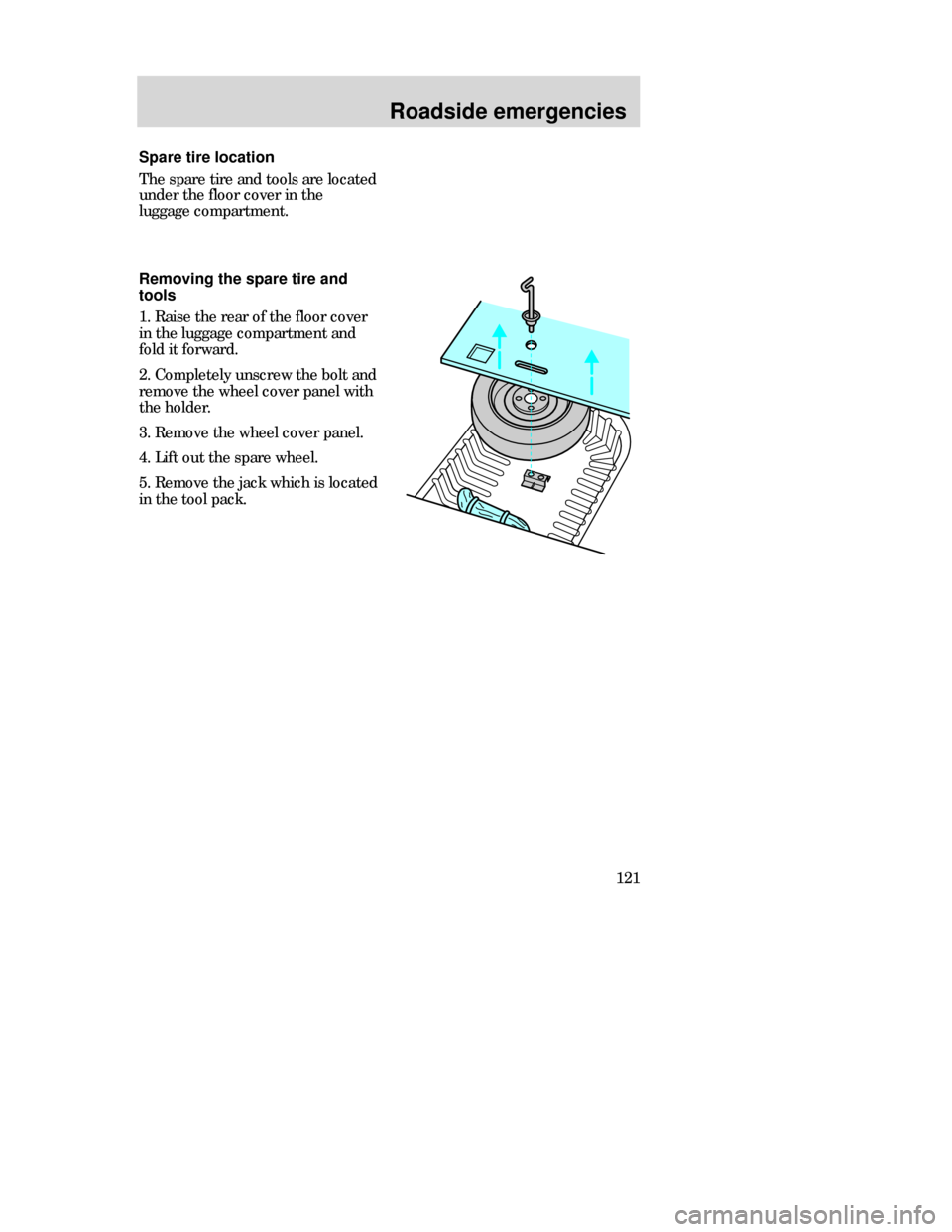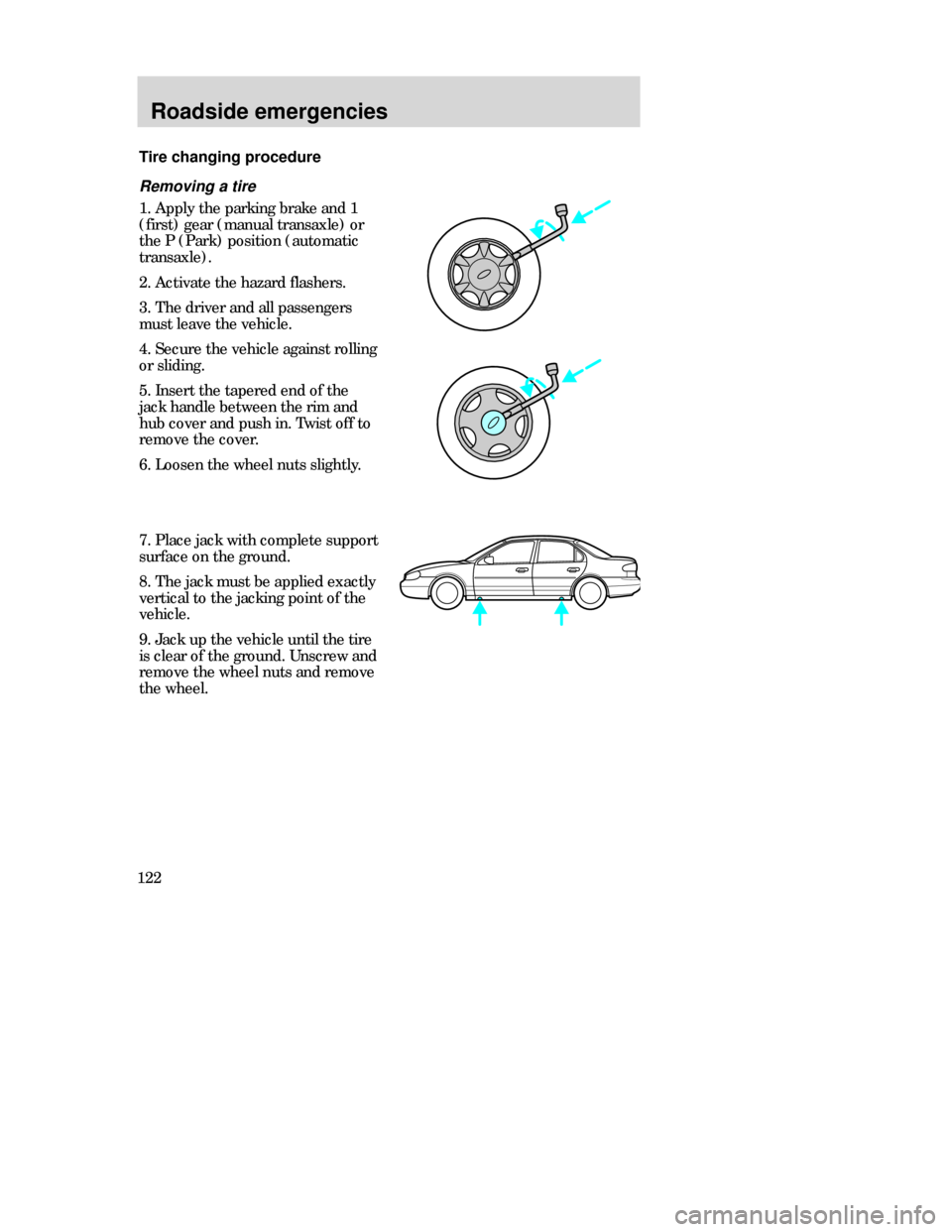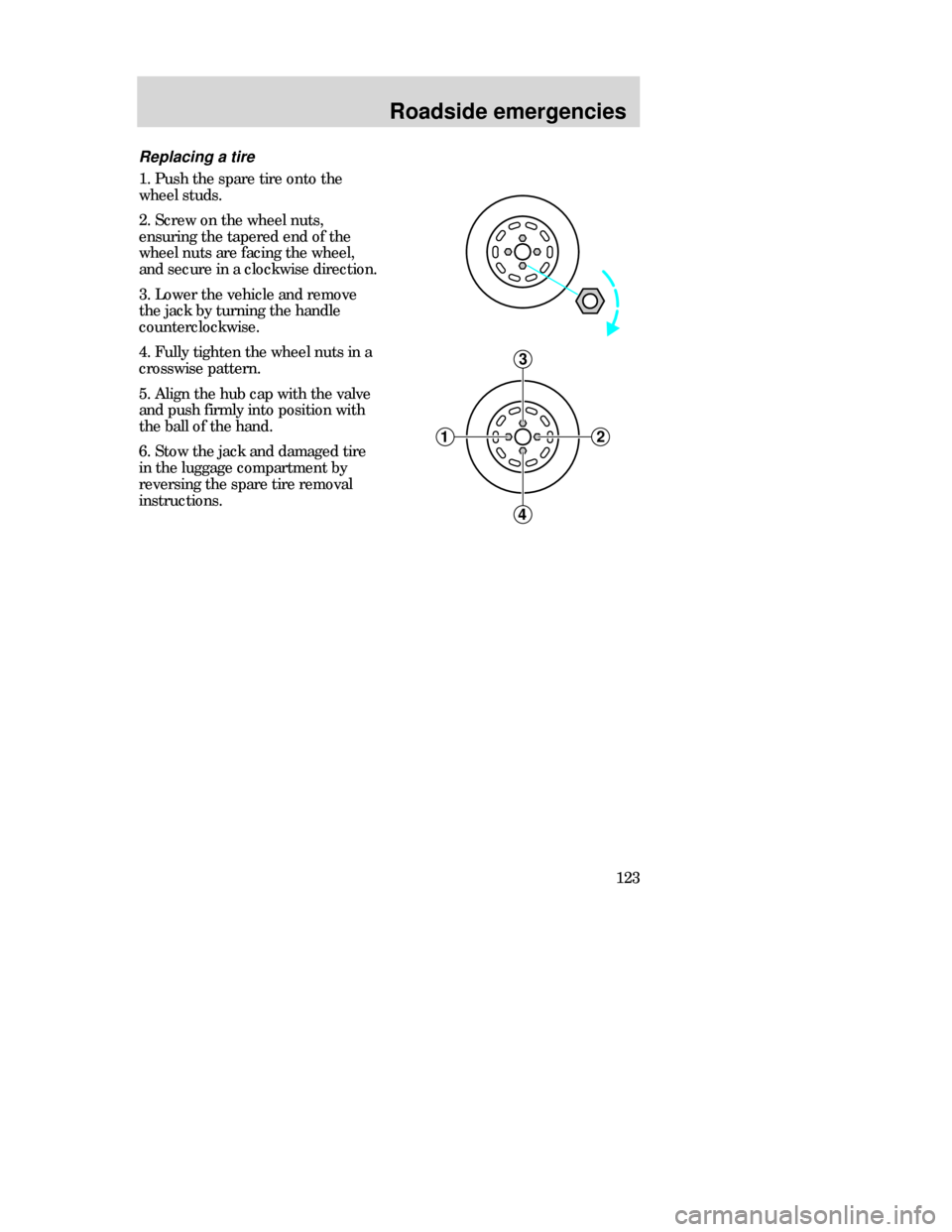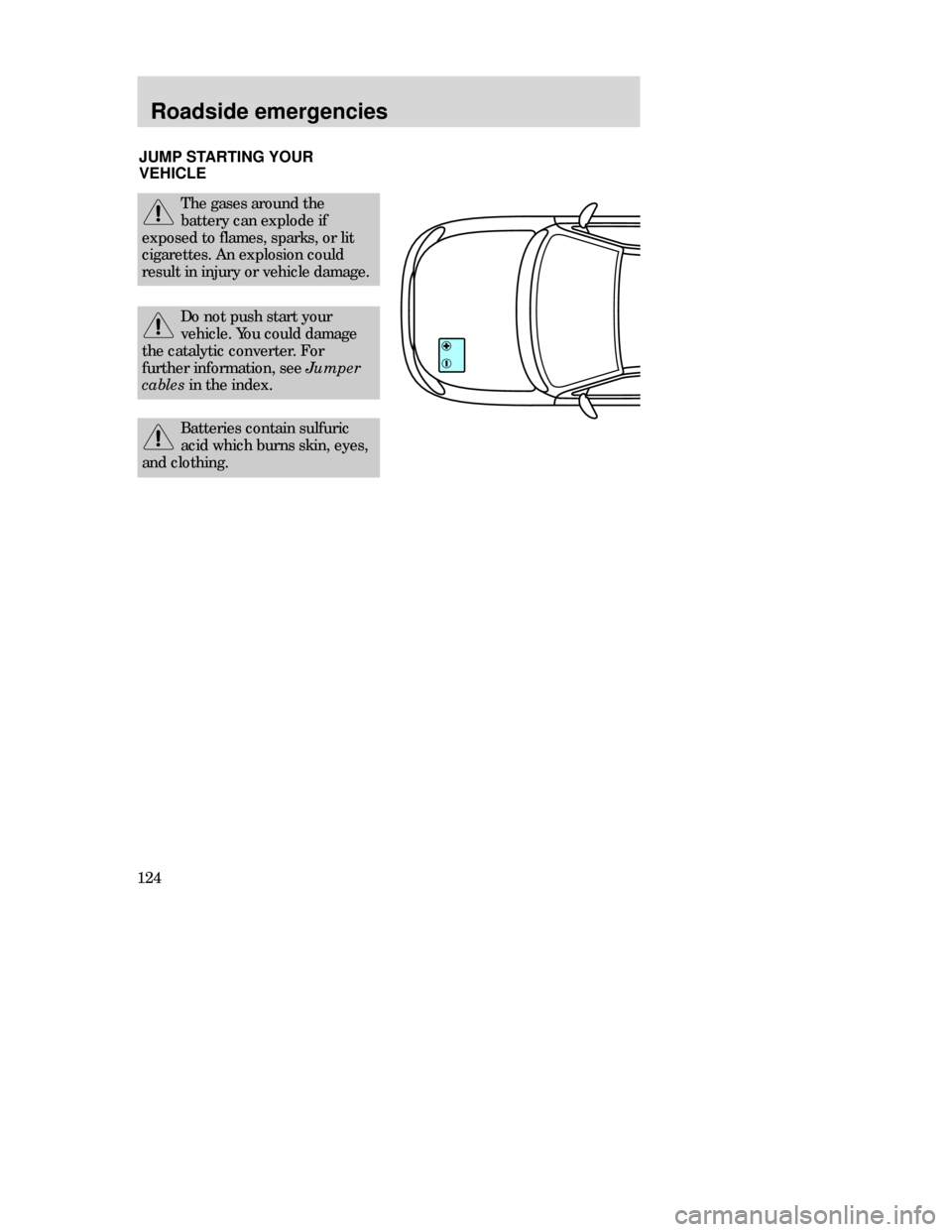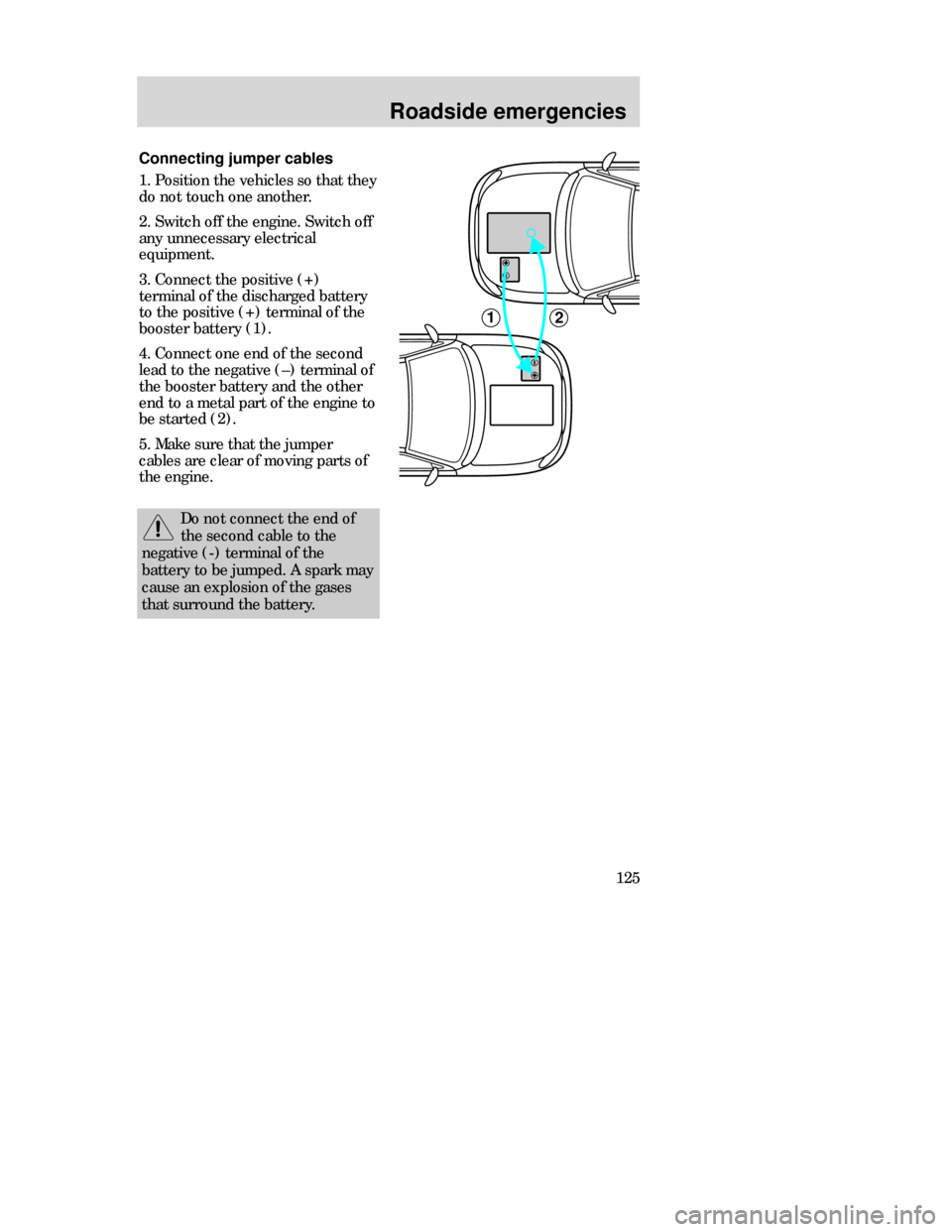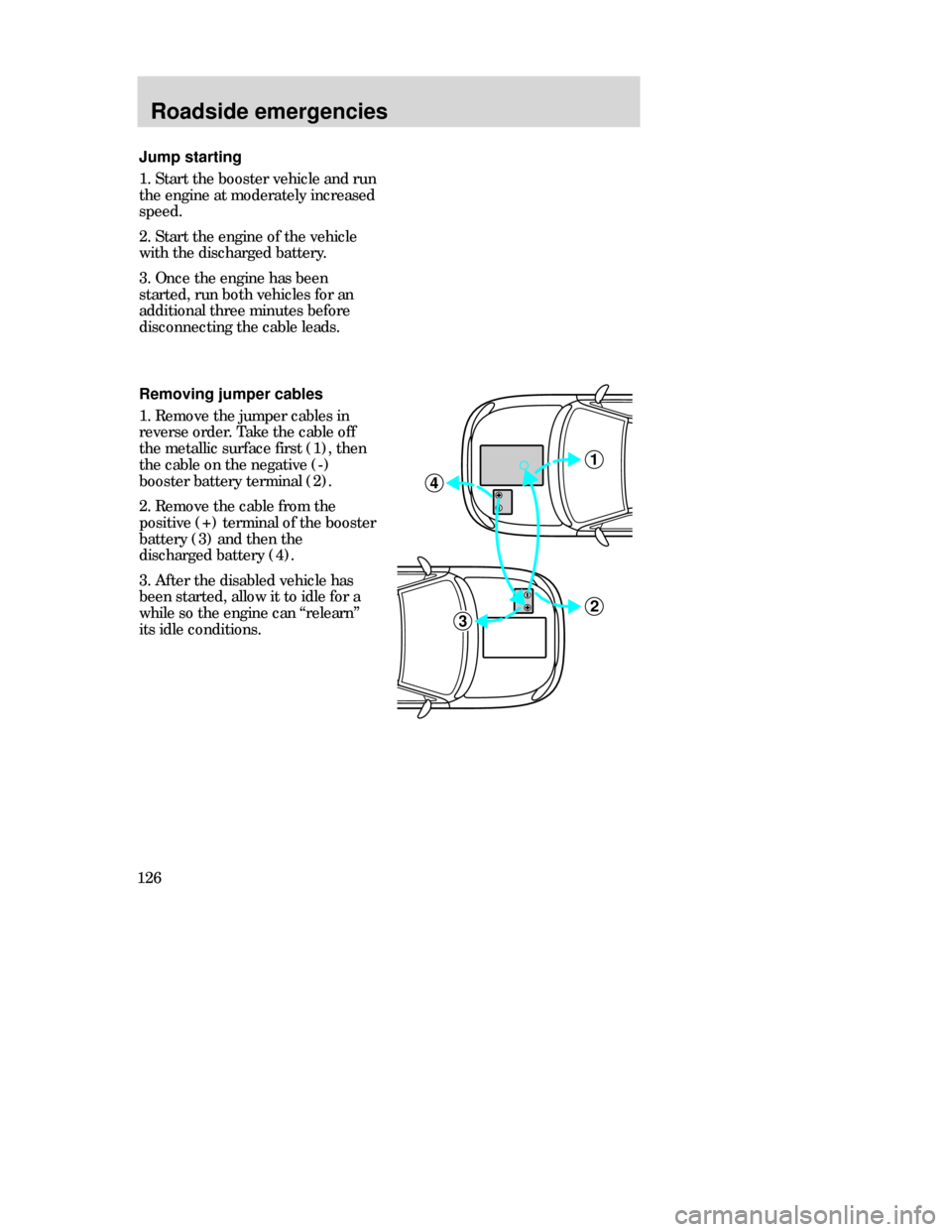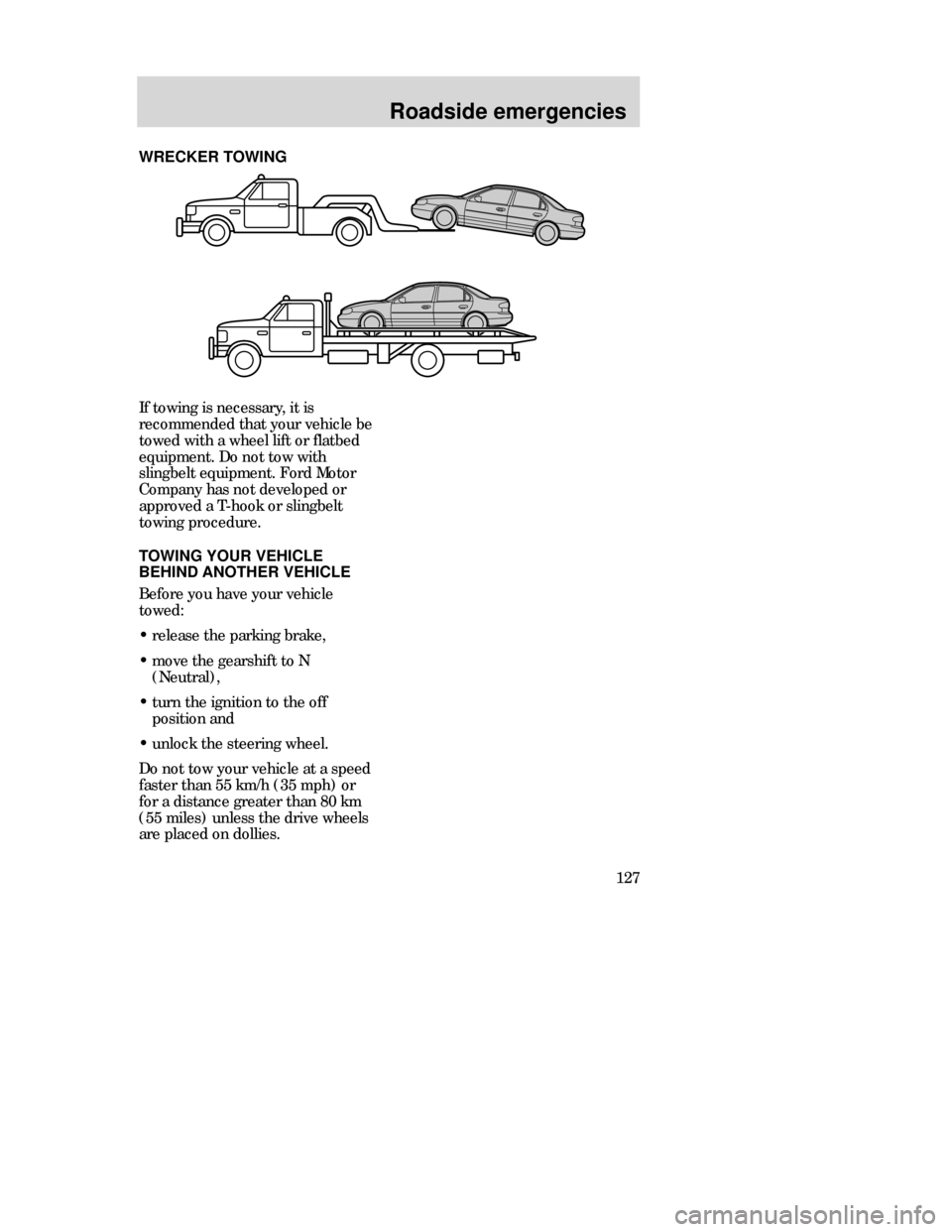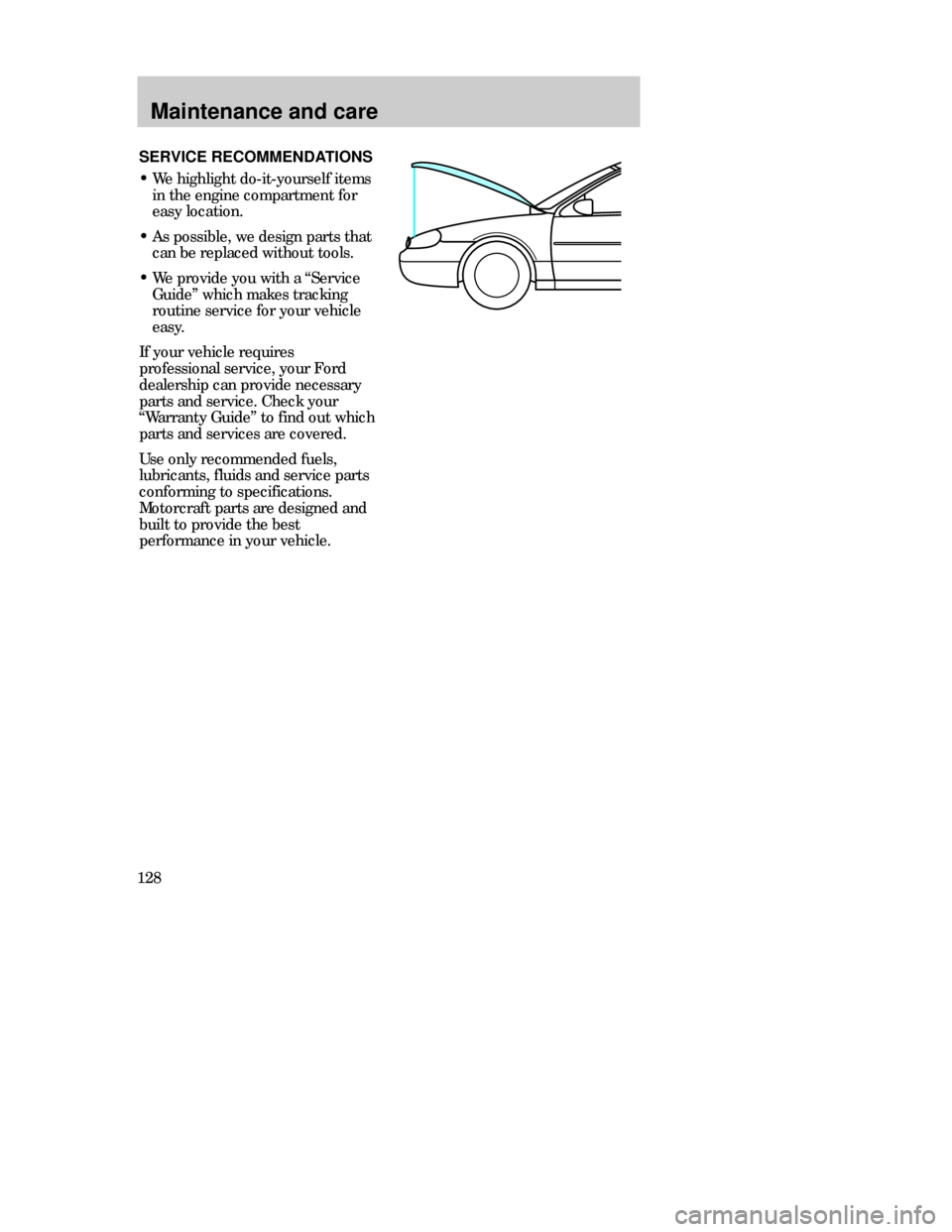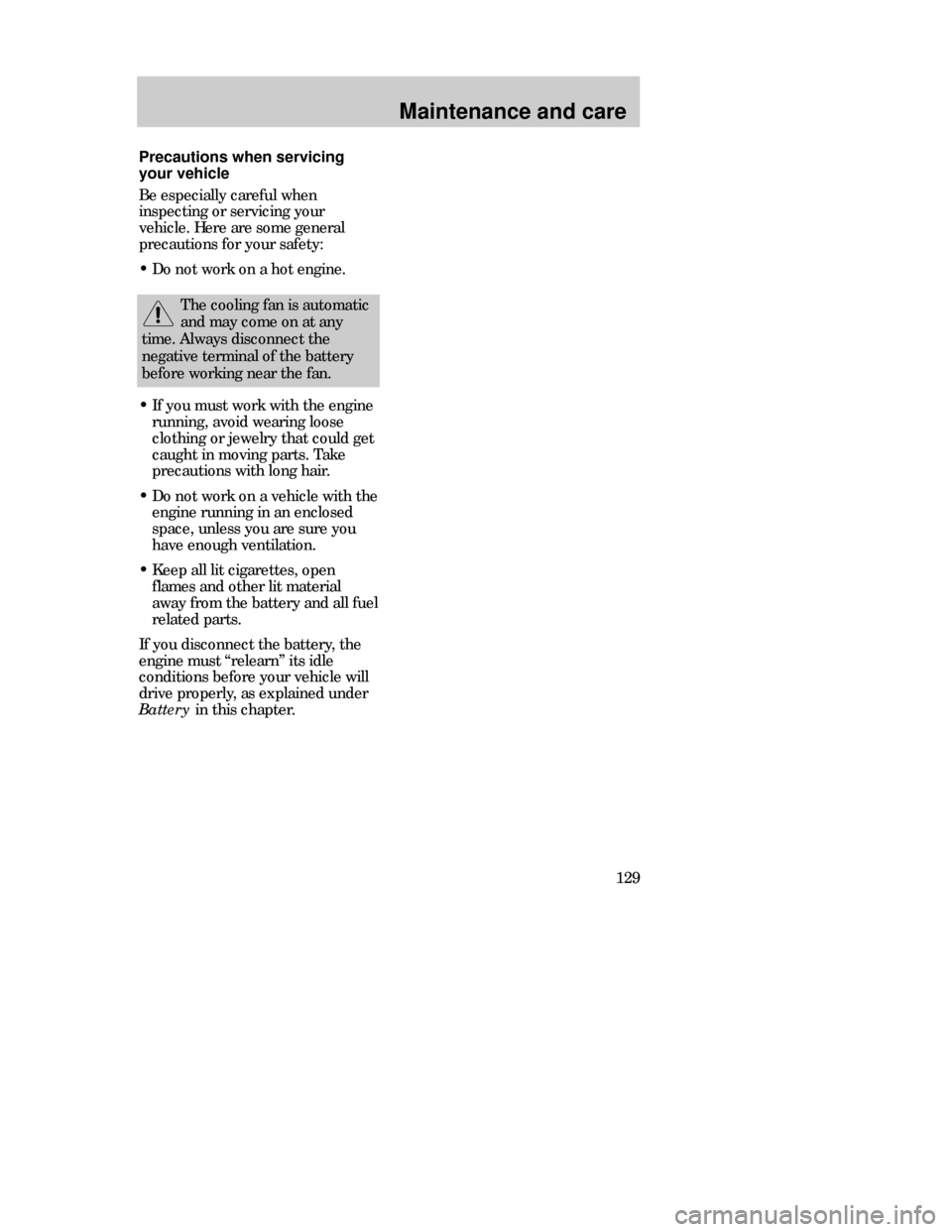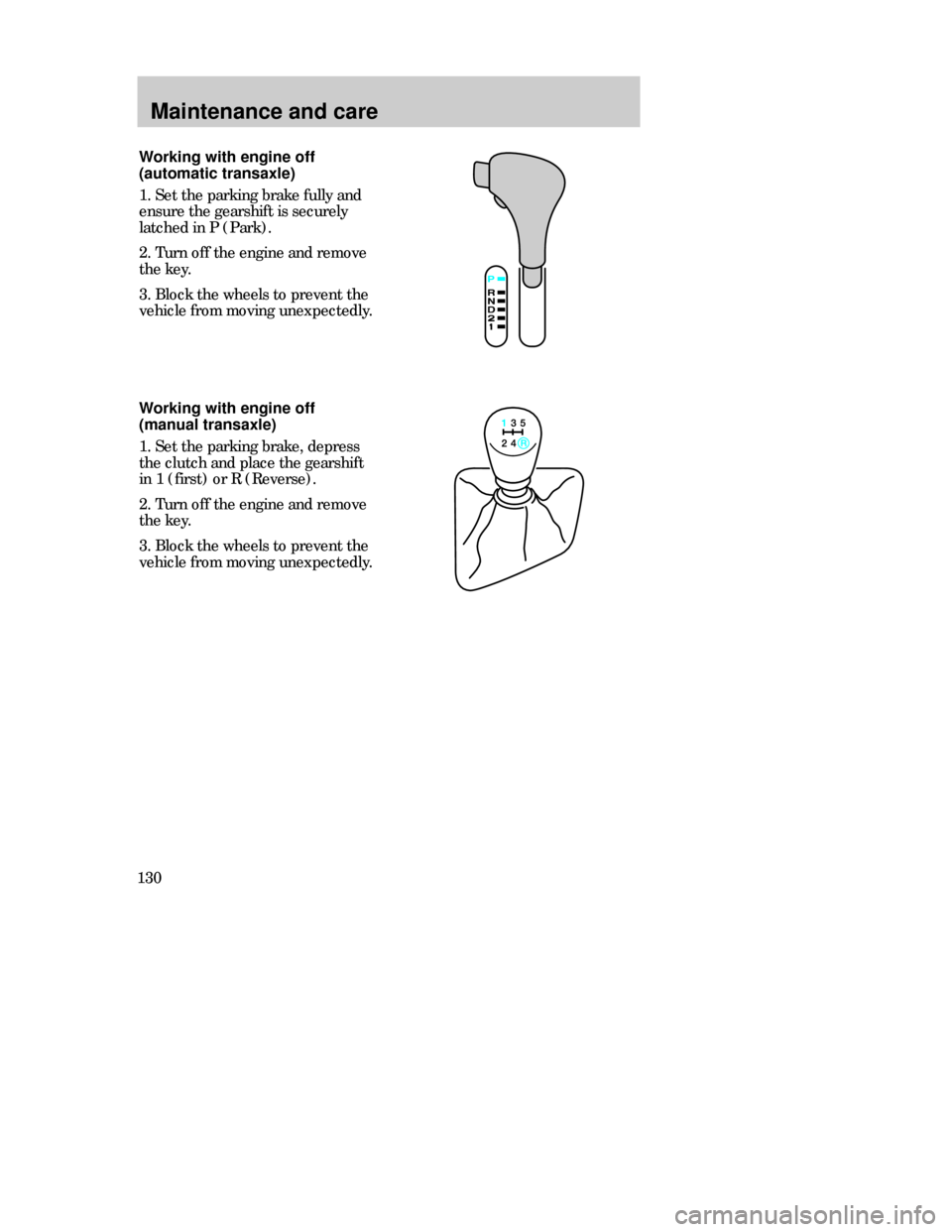FORD CONTOUR 1998 2.G Owners Manual
CONTOUR 1998 2.G
FORD
FORD
https://www.carmanualsonline.info/img/11/4767/w960_4767-0.png
FORD CONTOUR 1998 2.G Owners Manual
Trending: service interval, fog light, brakes, oil dipstick, service reset, high beam, radio controls
Page 121 of 200
Roadside emergencies
121 Spare tire location
The spare tire and tools are located
under the floor cover in the
luggage compartment.
Removing the spare tire and
tools
1. Raise the rear of the floor cover
in the luggage compartment and
fold it forward.
2. Completely unscrew the bolt and
remove the wheel cover panel with
the holder.
3. Remove the wheel cover panel.
4. Lift out the spare wheel.
5. Remove the jack which is located
in the tool pack.
CDW IVC1-6Roads en C 5/15/97 8:54 PM Page 121
Page 122 of 200
Roadside emergencies
122
Removing a tire
1. Apply the parking brake and 1
(first) gear (manual transaxle) or
the P (Park) position (automatic
transaxle).
2. Activate the hazard flashers.
3. The driver and all passengers
must leave the vehicle.
4. Secure the vehicle against rolling
or sliding.
5. Insert the tapered end of the
jack handle between the rim and
hub cover and push in. Twist off to
remove the cover.
6. Loosen the wheel nuts slightly.
Tire changing procedure
7. Place jack with complete support
surface on the ground.
8. The jack must be applied exactly
vertical to the jacking point of the
vehicle.
9. Jack up the vehicle until the tire
is clear of the ground. Unscrew and
remove the wheel nuts and remove
the wheel.
CDW IVC1-6Roads en C 5/15/97 8:54 PM Page 122
Page 123 of 200
Roadside emergencies
123
Replacing a tire
1. Push the spare tire onto the
wheel studs.
2.Screw on the wheel nuts,
ensuring the tapered end of the
wheel nuts are facing the wheel,
and secure in a clockwise direction.
3. Lower the vehicle and remove
the jack by turning the handle
counterclockwise.
4. Fully tighten the wheel nuts in a
crosswise pattern.
5. Align the hub cap with the valve
and push firmly into position with
the ball of the hand.
6. Stow the jack and damaged tire
in the luggage compartment by
reversing the spare tire removal
instructions.
3
42 1
CDW IVC1-6Roads en C 5/15/97 8:54 PM Page 123
Page 124 of 200
Roadside emergencies
124JUMPSTARTING YOUR
VEHICLE
The gases around the
battery can explode if
exposed to flames, sparks, or lit
cigarettes. An explosion could
result in injury or vehicle damage.
Do not push start your
vehicle. You could damage
the catalytic converter. For
further information, see
Jumper
cablesin the index.
Batteries contain sulfuric
acid which burns skin, eyes,
and clothing.
CDW IVC1-6Roads en C 5/15/97 8:54 PM Page 124
Page 125 of 200
Roadside emergencies
125 Connecting jumper cables
1. Position the vehicles so that they
do not touch one another.
2. Switch off the engine. Switch off
any unnecessary electrical
equipment.
3. Connect the positive (+)
terminal of the discharged battery
to the positive (+) terminal of the
booster battery (1).
4. Connect one end of the second
lead to the negative (–) terminal of
the booster battery and the other
end to a metal part of the engine to
be started (2).
5. Make sure that the jumper
cables are clear of moving parts of
the engine.
12
Do not connect the end of
the second cable to the
negative (-) terminal of the
battery to be jumped. A spark may
cause an explosion of the gases
that surround the battery.
CDW IVC1-6Roads en C 5/15/97 8:54 PM Page 125
Page 126 of 200
Roadside emergencies
126Jump starting
1. Start the booster vehicle and run
the engine at moderately increased
speed.
2. Start the engine of the vehicle
with the discharged battery.
3. Once the engine has been
started, run both vehicles for an
additional three minutes before
disconnecting the cable leads.
Removing jumper cables
1. Remove the jumper cables in
reverse order. Take the cable off
the metallic surface first (1), then
the cable on the negative (-)
booster battery terminal (2).
2. Remove the cable from the
positive (+) terminal of the booster
battery (3) and then the
discharged battery (4).
3. After the disabled vehicle has
been started, allow it to idle for a
while so the engine can “relearn”
its idle conditions.
2
1
3
4
CDW IVC1-6Roads en C 5/15/97 8:54 PM Page 126
Page 127 of 200
Roadside emergencies
127 If towing is necessary, it is
recommended that your vehicle be
towed with a wheel lift or flatbed
equipment. Do not tow with
slingbelt equipment. Ford Motor
Company has not developed or
approved a T-hook or slingbelt
towing procedure.
TOWING YOUR VEHICLE
BEHIND ANOTHER VEHICLE
Before you have your vehicle
towed:
•release the parking brake,
•move the gearshift to N
(Neutral),
•turn the ignition to the off
position and
•unlock the steering wheel.
Do not tow your vehicle at a speed
faster than 55 km/h (35 mph) or
for a distance greater than 80 km
(55 miles) unless the drive wheels
are placed on dollies. WRECKER TOWING
CDW IVC1-6Roads en C 5/15/97 8:54 PM Page 127
Page 128 of 200
Maintenance and care
128SERVICE RECOMMENDATIONS
•We highlight do-it-yourself items
in the engine compartment for
easy location.
•As possible, we design parts that
can be replaced without tools.
•We provide you with a “Service
Guide” which makes tracking
routine service for your vehicle
easy.
If your vehicle requires
professional service, your Ford
dealership can provide necessary
parts and service. Check your
“Warranty Guide” to find out which
parts and services are covered.
Use only recommended fuels,
lubricants, fluids and service parts
conforming to specifications.
Motorcraft parts are designed and
built to provide the best
performance in your vehicle.
CDW VA1-19Maint en C 5/15/97 8:55 PM Page 128
Page 129 of 200
Maintenance and care
129 Precautions when servicing
your vehicle
Be especially careful when
inspecting or servicing your
vehicle. Here are some general
precautions for your safety:
•Do not work on a hot engine.
The cooling fan is automatic
and may come on at any
time. Always disconnect the
negative terminal of the battery
before working near the fan.
•If you must work with the engine
running, avoid wearing loose
clothing or jewelry that could get
caught in moving parts. Take
precautions with long hair.
•Do not work on a vehicle with the
engine running in an enclosed
space, unless you are sure you
have enough ventilation.
•Keep all lit cigarettes, open
flames and other lit material
away from the battery and all fuel
related parts.
If you disconnect the battery, the
engine must “relearn” its idle
conditions before your vehicle will
drive properly, as explained under
Battery in this chapter.
CDW VA1-19Maint en C 5/15/97 8:55 PM Page 129
Page 130 of 200
Maintenance and care
130Working with engine off
(automatic transaxle)
1. Set the parking brake fully and
ensure the gearshift is securely
latched in P (Park).
2. Turn off the engine and remove
the key.
3. Block the wheels to prevent the
vehicle from moving unexpectedly.
Working with engine off
(manual transaxle)
1. Set the parking brake, depress
the clutch and place the gearshift
in 1 (first) or R (Reverse).
2. Turn off the engine and remove
the key.
3. Block the wheels to prevent the
vehicle from moving unexpectedly.
CDW VA1-19Maint en C 5/15/97 8:55 PM Page 130
Trending: oil, width, service interval, torque, remote start, trunk, oil level
